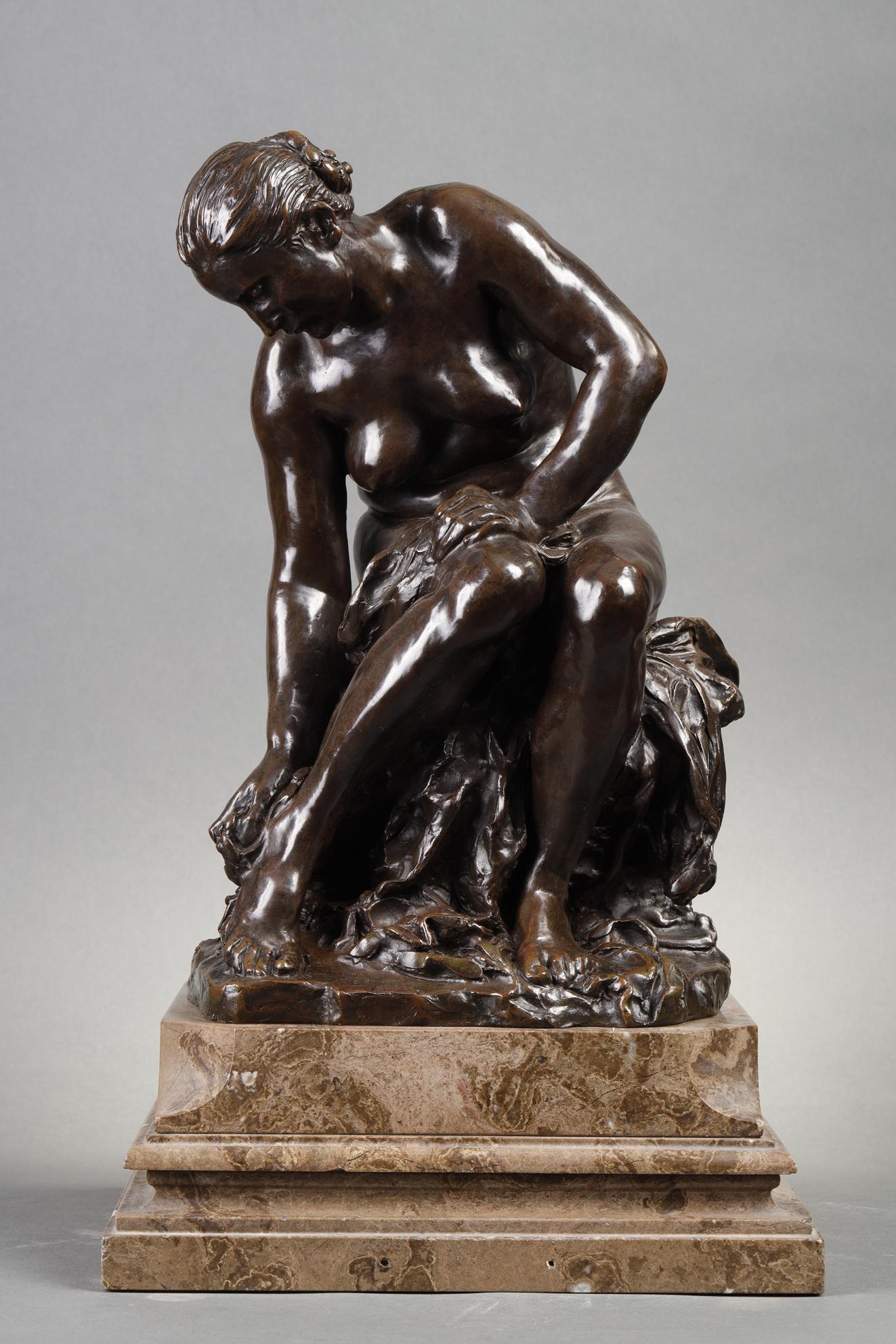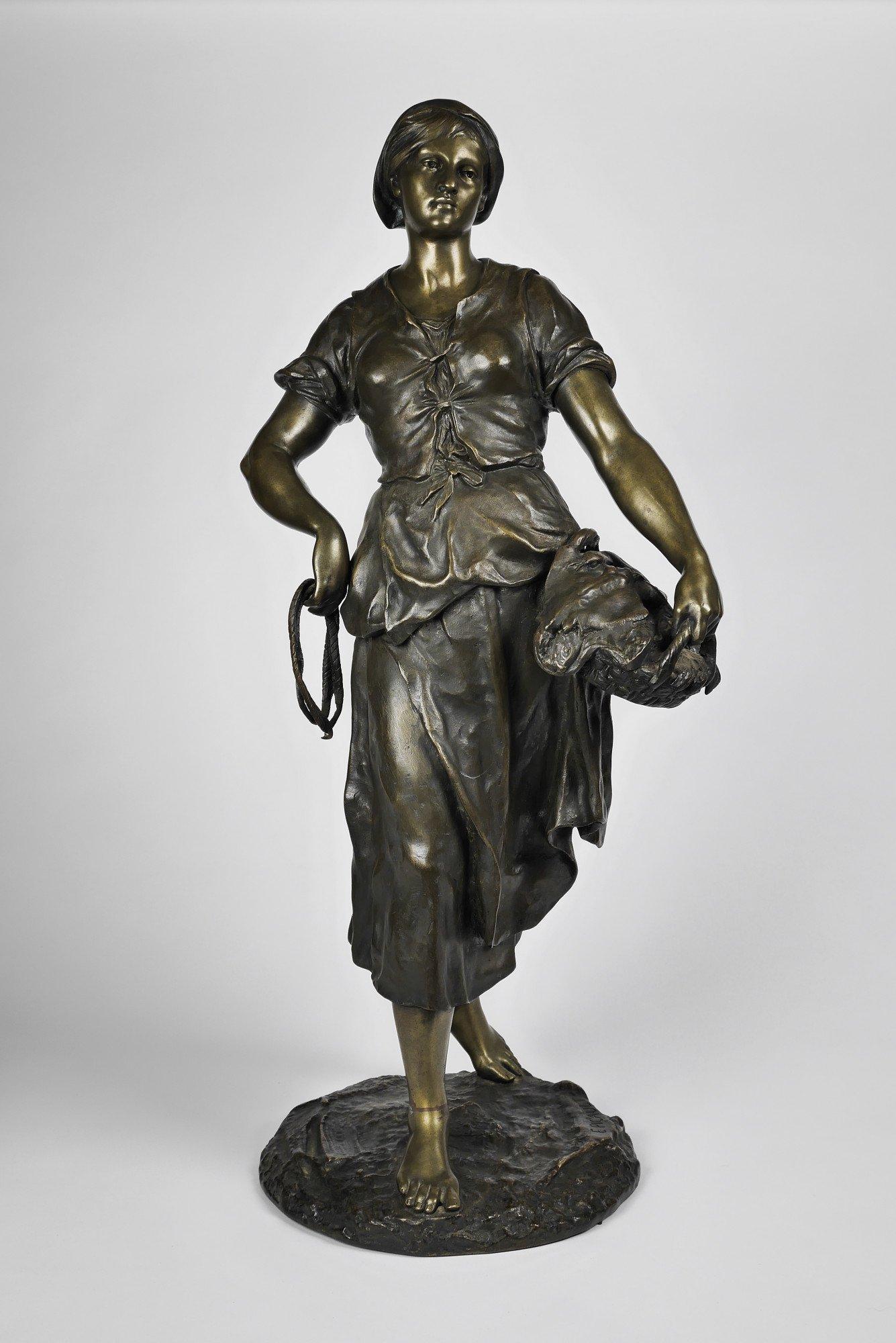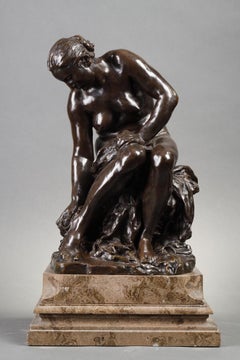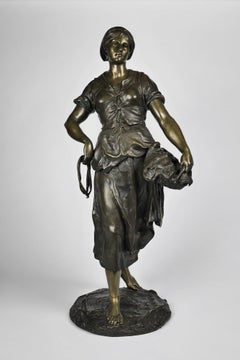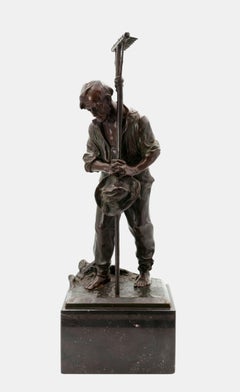Want more images or videos?
Request additional images or videos from the seller
1 of 7
Aimé-Jules DalouHay Pickercirca 1890
circa 1890
$4,483.47
£3,409.02
€3,800
CA$6,271.59
A$6,844.89
CHF 3,595.11
MX$83,134.29
NOK 45,111.78
SEK 42,336.15
DKK 28,943.94
About the Item
This Peasant resting is a subject that is included in the famous suite commonly called "little workers" by Jules Dalou (1838-1902)
Bronze with nuanced dark brown patina
cast by Susse Frères - stamped with the founder's seal
France
created around 1890 and cast after his death
height 12,5 cm
A similar model reproduced inJules Dalou, le sculpteur de la République, Exhibition held at the Musée du Petit Palais, Paris, 2013, page 288, n°220.
Biography :
Aimé-Jules Dalou, said Jules Dalou (1838-1902) was a French sculptor, born from Protestants glovers craftsmen who raised in secularism and love of the Republic. Jules Dalou was very young talented for modeling and drawing, which earned him the attention of Jean-Baptiste Carpeaux, who made him entered in 1852 in the Little School, the future National School of Decorative Arts in Paris. In 1854, he was admitted to the School of Fine Arts in Paris, where he studied painting in the workshop of Abel de Pujol and sculpture in the workshop of Francisque Duret. He began to earn his living by working for decorators, and began his friendship with Auguste Rodin. Dalou then produced decorative sculptures for buildings on major Parisian avenues, such as the Hotel de la Paiva, on the Champs-Elysees Avenue. He presented but failed four times to Rome prize competition, but exhibited at the 1869 Salon his "Daphnis and Chloe" and the "Embroiderer" at the Salon of 1870, two pieces acquired by the French state. Dalou had one child, Georgette, a girl born with a mental handicap. This is to ensure funding for her daughter's life accommodation in the Orphanage of Arts, that Dalou bequeathed the funds from his workshop to this institution.
After the bloody week of May 1871 Dalou, his wife and their daughter were threatened as Communards, forced into exile and requested asylum. They then joined England and were greeted by his former fellows of the Little School, the painter Alphonse Legros. With Legros, much introduced in the City, he made a serie of terracotta statuettes inspired by boulonnaise peasants or intimate subjects (readers, lullabies), and portraits of the English aristocracy. He became professor for modeling at the National Art Training School, his influence was decisive for many British sculptors. He received orders for a public fountain in marble titled "Charity" (1877) near the Royal Exchange in London, and a monument dedicated to Queen Victoria's grandchildren located in the private chapel of Frogmore at Windsor Castle.
In May 1874, the Paris War Council condemned him in absentia to hard labor for life. Having refused to beg for mercy, Dalou was only in May 1879 being granted amnesty and his family finally returned from exile. His group "The Triumph of the Republic", originally planned for the Place de la Republique in Paris, was finally erected on the Place du Trône, renamed Place de La Nation in 1880. Dalou devoted twenty years to the realization of this monument. The years 1881 and 1882 were difficult, but the 1883 Salon finally revealed him to the French public. He exhibited his two high reliefs: "The Brotherhood of Peoples" and "Mirabeau answering Dreux-Brézé", for which he was awarded the Medal of Honor. Fleeing the world and living in family, Dalou engaged in considerable work and many orders both private and public. For the Universal Exhibition of 1889, was inaugurated on the Place de la Nation the plaster of "The Triumph of the Republic" commissioned by the city of Paris in 1879. Although the bronze version of the group was inaugurated in 1899, this work won the grand prize for sculpture in the exhibition. Dalou left the French Society of Artists in 1890 to expose at the National Society of Fine Arts, of which he was a founding member with Ernest Meissonier, Auguste Rodin and Pierre Puvis de Chavannes. Awarded Knight of the Legion of Honor in 1883, and promoted to officer by President Carnot in 1889, he was elevated to the rank of Commander of the same order in 1899 by President Loubet at the inauguration of the monument of "The Triumph of the Republic".
Dalou had no time to complete his last great project, a monument dedicated to workers, the idea came to him in 1889 after the first opening of "TheTriumph of the Republic". The formality of the ceremony and military parades held the people away from the official event. Dalou was disappointed. True to its republican ideals, he had hoped that this inauguration was an opportunity of great popular democratic party (as it was at the inauguration of the bronze in 1899). His idea was then to pay tribute to the world of workers, craftsmen and peasants with this work being the central subject. At the end of his career Dalou described the project as follows: "I think I have finally found the monument to the workers that I seek since 1889. Sober, without molding or ornament, I wish it'd be severe and imposing. Will I execute it? There is the question. I am old and my health is so weak."
The numerous sketches of the monument found in his studio after his death are now preserved in the Musée du Petit Palais in Paris. The statue of the Great Peasant (around 1897 to 1902, Paris, Musée d'Orsay) prefigures the characters he planned to place in the sixteen niches surrounding the column, a monument of 32 meters high.
- Creator:Aimé-Jules Dalou (1838 - 1902, French)
- Creation Year:circa 1890
- Dimensions:Height: 4.93 in (12.5 cm)Width: 3.55 in (9 cm)Depth: 2.56 in (6.5 cm)
- Medium:
- Movement & Style:
- Period:
- Condition:
- Gallery Location:PARIS, FR
- Reference Number:Seller: N.54831stDibs: LU2514212584782

About the Seller
5.0
Recognized Seller
These prestigious sellers are industry leaders and represent the highest echelon for item quality and design.
Gold Seller
Premium sellers maintaining a 4.3+ rating and 24-hour response times
Established in 1992
1stDibs seller since 2023
11 sales on 1stDibs
Typical response time: 14 hours
- ShippingRetrieving quote...Shipping from: PARIS, France
- Return Policy
Authenticity Guarantee
In the unlikely event there’s an issue with an item’s authenticity, contact us within 1 year for a full refund. DetailsMoney-Back Guarantee
If your item is not as described, is damaged in transit, or does not arrive, contact us within 7 days for a full refund. Details24-Hour Cancellation
You have a 24-hour grace period in which to reconsider your purchase, with no questions asked.Vetted Professional Sellers
Our world-class sellers must adhere to strict standards for service and quality, maintaining the integrity of our listings.Price-Match Guarantee
If you find that a seller listed the same item for a lower price elsewhere, we’ll match it.Trusted Global Delivery
Our best-in-class carrier network provides specialized shipping options worldwide, including custom delivery.More From This Seller
View AllHay Baler
By Aimé-Jules Dalou
Located in PARIS, FR
This Hay baler is a subject that is included in the famous suite commonly called "little workers" by Jules Dalou (1838-1902)
Bronze with dark brown patina
c...
Category
Late 19th Century French School Figurative Sculptures
Materials
Bronze
Suzanne
By Aimé-Jules Dalou
Located in PARIS, FR
Bathing woman drying her right foot
also known as "Suzanne"
by Aimé-Jules DALOU (1838-1902)
A bronze sculpture with a nuanced dark brown patina
Signed on the base " Dalou "
A very...
Category
Early 20th Century French School Figurative Sculptures
Materials
Bronze
Paver
By Aimé-Jules Dalou
Located in PARIS, FR
This paver is a subject that is included in the famous suite commonly called "little workers" by Jules Dalou (1838-1902)
Bronze with dark brown patina
cast by Susse Frères - stamped...
Category
Late 19th Century French School Figurative Sculptures
Materials
Bronze
Desperate
By Aimé-Jules Dalou
Located in PARIS, FR
Desperate
by Jules DALOU (1838-1902)
A bronze sculpture with a nuanced dark brownish-green patina
Signed on the base " Dalou "
Cast by " Susse Frères Editeurs Paris " (with the fou...
Category
Late 19th Century French School Nude Sculptures
Materials
Bronze
$10,663
"Charity" also known as "Motherhood"
By Aimé-Jules Dalou
Located in PARIS, FR
"Charity"
also known as "Motherhood"
by Aimé-Jules DALOU (1838-1902)
A beautiful bronze group sculpture with a nuanced dark brown patina
Signed on the base "Dalou"
A very fine cas...
Category
Late 19th Century French School Figurative Sculptures
Materials
Bronze
Symbole
Located in PARIS, FR
Horse "Symbole"
by René PARIS (1881-1970)
Animal sculpture in bronze with a nuanced light brown patina
signed on the base "René Paris"
and dated "1942"
Cast by "A. Valsuani" (with f...
Category
1940s French School Figurative Sculptures
Materials
Bronze
$10,618
You May Also Like
The Fisherwoman, 19th century French bronze sculpture
By Émile Louis Picault
Located in Beachwood, OH
Émile Louis Picault (French, 1833-1915)
Fisherwoman
Bronze
Stamped "E. Picault"
30 x 15 x 12 inches
Subject depicting a young woman holding fishing line in one hand a basket of fis...
Category
19th Century Figurative Sculptures
Materials
Bronze
Field worker with rake / - The Humility of the Farm Worker -
Located in Berlin, DE
Paul Ludwig Kowalczewski (1865 Mieltschin - 1910 Berlin), Field worker with rake, around 1900. Brown and brown-greenish patinated bronze with ...
Category
Early 1900s Realist Figurative Sculptures
Materials
Bronze
$1,510 Sale Price
20% Off
Eugène Laurent (1832-1898), The Beachcomber
Located in Berlin, DE
Eugène Laurent (1832-1898),
The Beachcomber
Inscribed "E. Laurent" on the base plate in the cast.
H 63 cm
Eugène Laurent studied at the École des Beaux-Arts in Paris and was awa...
Category
Early 19th Century Jugendstil Figurative Sculptures
Materials
Bronze
La Fileuse
By Albert-Ernest Carrier-Belleuse
Located in London, GB
signed 'A. CARRIER-BELLEUSE' (on base)
Category
Mid-19th Century Figurative Sculptures
Materials
Bronze
A Harvesting Girl Statue by A . J . Scotte, 1885-1905
By A.J. Scotte
Located in Lisbon, PT
A neoclassical Harvesting Girl Spelter statue by A. J . Scotte (1885-1905) signed and dated ”1906” with foundry stamp mark on the base.
Ideal for Classical schemes that needs a beau...
Category
Early 20th Century French Neoclassical Figurative Sculptures
Materials
Spelter
$2,902 Sale Price
20% Off
Hans Schork "The Sower" Patinated Bronze
Located in Astoria, NY
Hans Schork (Austrian, b.1849) "The Sower" Patinated Bronze Sculpture, late 19th century, after the model by Louis-Oscar Roty (French, 1846-1911), the stan...
Category
Late 19th Century Figurative Sculptures
Materials
Bronze
More Ways To Browse
French Seal
Antique Pickers
Jean Baptiste Carpeaux
19th Century Bronze Knight Sculpture
Richard Macdonald Elena
Richard Macdonald Sissone
Richard Orlinski Panther
Salvador Dali Ceramic
Salvador Dali Tile
Silver Sculpture Salvador Dali
Sima Josef
Spray Paint Can Sculpture
Stanislaw Wysocki
Susan Kemenyffy
Taller Alfonso Castillo Orta
Tete De Chevre De Profil
Thalia Sculpture
Waldo Peirce
